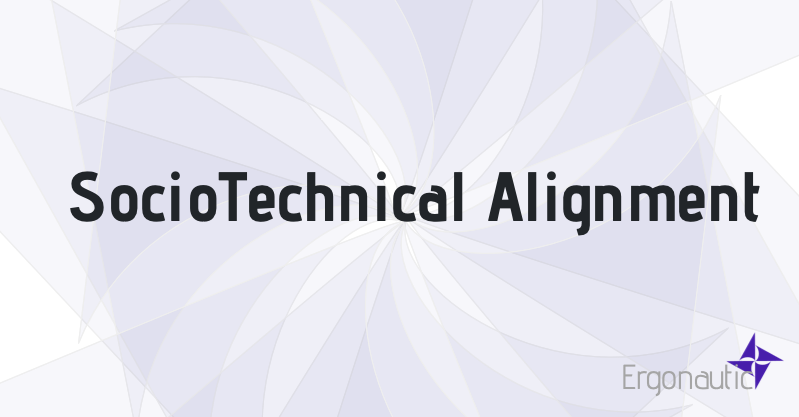
Sociotechnical Alignment - Co-Designing for Co-Evolution, Resilience, and Real Value
“The way forward has less to do with arguing about the words and more about grappling with the difficult and emergent relationship between the human and the technical.” — DevOps de los Muertos
Often when we work with organizations we find ourselves needing to explain the idea of SocioTechnical Alignment.
Organizations don’t just run on technology—they emerge from the interactions between systems of people and technologies navigating uncertainty. The contextural complexity organizations find themselves in requires that they purposefully align the social and the technical. It isn’t a question of treating technology like a cost center, or reducing humans to mere automatable agents. To get the most out of humans and technologies interacting requires something else at Ergonautic, we call this Sociotechnical Alignment—not a buzzword, but a necessary design orientation for navigating the real work of change.
What Do We Mean by Sociotechnical Alignment?
In seeking to influence, or steer, behaviours within an IS engagement it is first necessary to study the interaction patterns and neighbourhoods of actors. Which actors need to be brought together or kept apart, and to what likely effect? What new neighbourhoods need to be created or destroyed? An analysis of neighbourhoods should not focus solely upon human actors, but non-human actors such as the IS as well. Kim, R. M., & Kaplan, S. M. (2006). Interpreting socio‐technical co‐evolution: Applying complex adaptive systems to IS engagement. Information Technology & People
Sociotechnical alignment isn’t a maturity model or a checklist—it’s the deliberate co-design of infrastructure, workflows, roles, policies, and feedback loops so that the social and technical evolve together as mutually constituted systems, inseparable in practice.
Too often, transformation efforts isolate technology as the solution—buying tools, lifting workloads, renaming functions—without shifting how people relate to each other or how decisions get made. These changes stall because they overlook how tools, archtectures and technologies embed expectations, structure attention, and redistribute power.
From Joint Optimization to Co-Evolution
“The dynamics of embedding change (called transitions by Grin et al. 2010) are co-evolution processes involving novelties development, their use and adoption, and the adaptation and adjustment of their institutional, organisa- tional, regulative, praxis contexts…” – Concilio et al. (2019)
Building on the roots of the Tavistock tradition, sociotechnical alignment acknowledges that the work system is a dynamic process of intra-action. You can’t optimize technology and people separately without introducing significant friction into their interdependence.
In many contemporary environments, boundaries blur. Platforms mediate trust. Infrastructure becomes ephemeral. The challenge isn’t just coordination—it’s designing for co-evolution.
You don’t build resilience with command-and-control. You align for emergence. You structure feedback so systems can adapt.
Five Dimensions of Sociotechnical Alignment
1. Technical Systems Architecture isn’t neutral. Design for transparency, modularity, and adaptability—not just uptime. Your tools enable or hinder how work flows through your systems.
2. Operational Workflows Don’t “lift and shift” yesterday’s org chart and processes onto a new stack. Align tasks to where decisions get made. Reflect realities, not org fictions.
3. Situated Roles and Relationships Roles are not just job titles—they’re indicate how the social and technical are mutually constituted within your systems. Recognize where expertise lives. Design with, not for. Roles should be about reflexive relations as much or more than independent responsibilities and skills.
4. Governance and Incentives Are your feedback loops built to learn—or to hold individuals accountable? Align incentives to reinforce shared goals and systemic resilience.
5. Reflexive Culture No system is static. Embed mechanisms that help teams sense misalignment and make local adaptations without waiting for permission.
What You Get
SocioTechnically Aligned systems are adaptive systems. They don’t just absorb disruption—they learn from it. The payoff isn’t theoretical:
- Resilience: Shared sensemaking and engagement with systems-as-they-are.
- Responsiveness: Teams close to the work are empowered to act.
- Co-created Value: Value emerges in the interaction—not in isolated functions.
The Work Is Never Done
Sociotechnical alignment isn’t a finish line. It’s a capability—cultivated over time, embedded in the work itself.
At Ergonautic, we don’t do cookie-cutter transformation. We help teams make sense of their real constraints, their real dependencies, and build better ways of working from there.
If your current strategy feels haunted—by legacy tooling, by invisible labor, by zombie processes—it’s time to see the system.
We can help.